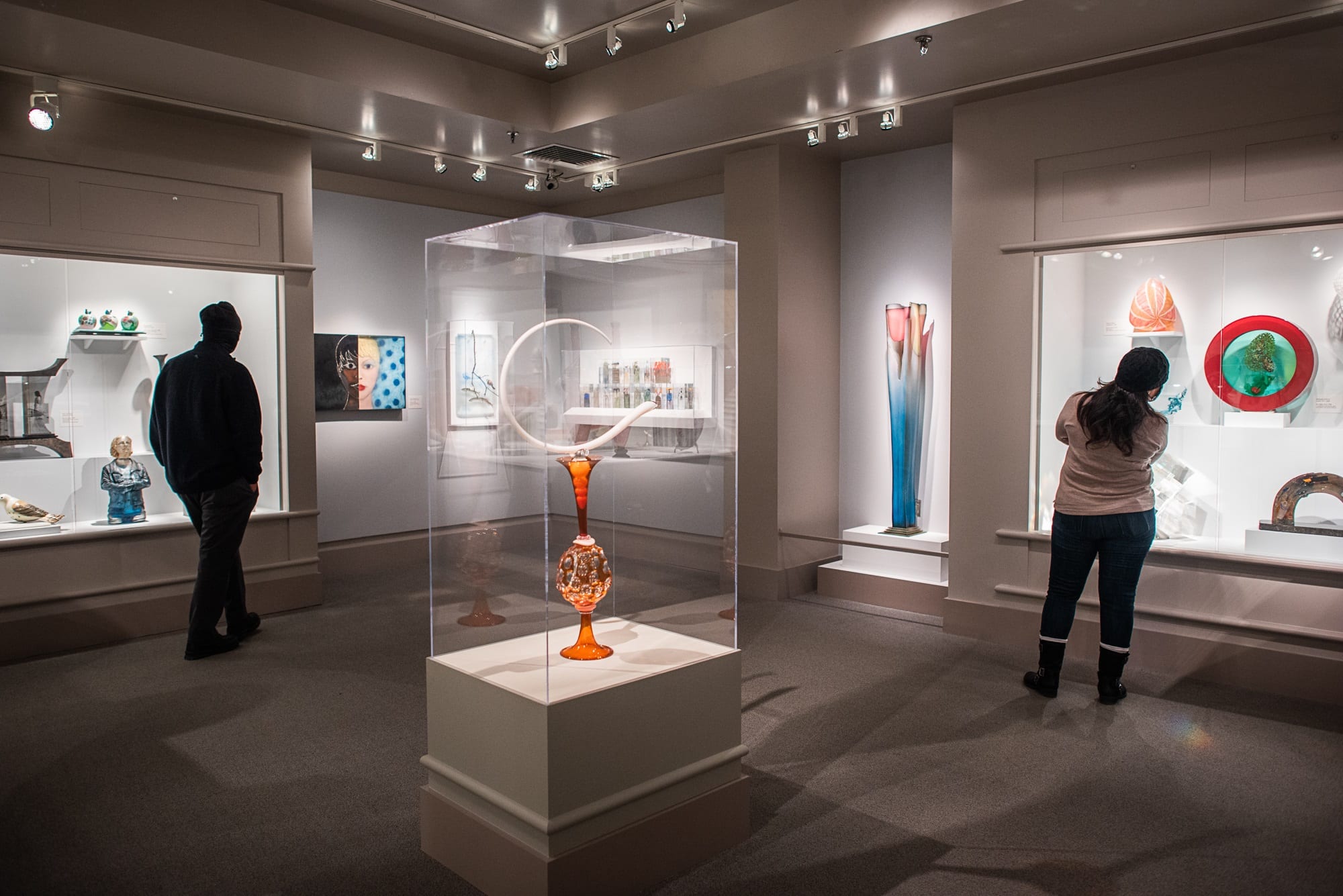
With the Palmer back open, visitors browse the Tonkin Gallery, which showcases the museum’s holdings of contemporary studio glass and ceramics from around the world.

With the Palmer back open, visitors browse the Tonkin Gallery, which showcases the museum’s holdings of contemporary studio glass and ceramics from around the world.
For the first time since it closed last March because of the pandemic, Penn State’s Palmer Museum of Art is welcoming visitors inside its doors again.
Patrons will notice new coronavirus procedures set in place to protect the community, according to Museum Director Erin Coe. Visitors must reserve a ticket online so that the museum can maintain strict occupancy limits. The front desk is now staffed to answer patrons’ questions, tours are self-guided only, and all visitors are required to practice social distancing and wear masks.
But safety protocols aren’t the only changes made in the 11 months before the museum’s reopening on Feb. 10. Museum staff undertook multiple projects, including renovations, rehousing collections, and digitizing art, Coe says, in addition to running programs online for the duration of the remote period.
“Migrating our programs, exhibitions, and events to the virtual realm was challenging,” Coe says, “but we overcame the technological obstacles and discovered new opportunities for engagement with our audiences, and we did so quickly and with great success.”
Though the museum was closed to visitors, Coe notes that “museums cannot work remotely,” so some essential workers were still taking care of artwork entrusted to the Palmer. Renovations during this period included repairing sections of the museum’s lobby walls and ceiling that had been damaged by a pipe leak in the summer. No artwork was damaged, Coe says, but the lobby and museum store were repainted for the first time since 1993.
The closure also presented the staff an opportunity to advance on a major collection rehousing project, Coe says. Because of the Palmer’s rapid growth, Penn State offered the museum additional storage space at Cato Park in 2018. Though the rehousing is not yet finished, Coe says there has been major progress made, as many varieties of art were packed, transported, and inventoried at the new facility.

“As our collection continues to grow, we are grateful to the university for supporting this important project which will improve preservation of and access to the museum’s invaluable collections for years to come,” Coe says.
The museum is also hoping to improve access to art through digitization efforts, she adds. Prior to the temporary closure, Coe says the museum’s “digital footprint was quite small.” To change that, staffers worked during the Palmer’s closure to photograph collections as the team hopes to digitize 10,000 works. The team is halfway there, Coe says.
“We made considerable progress on photographing works in the collection,” she says. “These digital images will greatly enrich our online presence, digital offerings, and other initiatives, including the new online searchable collection database moving forward.”
Coe says she was both excited and nervous for the museum to reopen, though she’s confident that the museum’s safety plans and art collections will “meet if not exceed” visitors’ expectations.
Museum Educator Brandi Breslin has helped plan for the reopening. The planning team looked to other examples of museums that were able to safely move to in-person operations, and while the Palmer is back open to visitors, there are no in-person events, she says.
“We’re constantly assessing when we’ll be able to make that next step,” Breslin says. “So, for now, we’re eager to welcome people back for individual or family group self-guided museum experiences and online programs.”
Changes in the museum’s operation over the past year have consequently meant changes in Breslin’s everyday work as the museum educator. She says her “essential role” to interpret collections and educate the Penn State community has not changed, but her methods of doing so have. To adapt, Breslin says she utilized tools such as video, photography, and other software, helping her make “giant leaps into the world of virtual museum programs.”
Ultimately, Breslin says, she is happy that visitors are able to return in-person.
“With timed ticketing and reduced occupancy, it may be a little quieter than before, but there are many people who are anxious to get out and do something different, something they enjoyed before the pandemic,” she says. “A stroll through the galleries with beautiful and stimulating artwork seems perfect.”
The Palmer will continue to offer online services and events, such as live talks and “Art After Hours,” Breslin says.
Looking forward, Coe says her team is planning for the museum’s future home at the Arboretum. But for now, she and her staff are enjoying the time for which they spent 11 months preparing.
“We are going to take a conscious pause, catch our breath, and enjoy this moment as we renew our public service commitment to Penn State and our community,” she says.
The new director of the Penn State School of Visual Arts, Vagner Mendonça-Whitehead, visited the museum for the first time in February, calling his experience “delightful.”
From a cultural standpoint, Mendonça-Whitehead says, museums provide an important function for any community, providing a connection to the past as well as opportunities to engage with creativity.
“The Palmer serves both Penn State and State College communities,” he says. “It has a collection that spans many eras, media, themes, and practices – the curatorial choices on display right now are quite moving.”
See more about the Palmer’s 2021 exhibition lineup here.
For more information, visit palmermuseum.psu.edu.
Receive all the latest news and events right to your inbox.

80% of consumers turn to directories with reviews to find a local business.